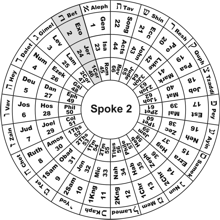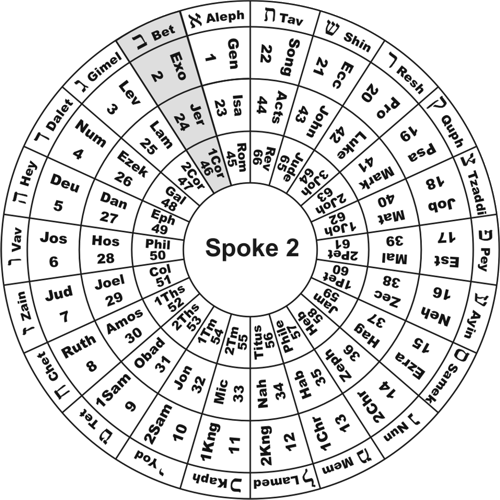The Call of Two Prophets
Then the word of the LORD came unto me, saying, Before I formed thee in
the belly I knew thee; and before thou camest forth out of the womb I sanctified thee,
and I ordained thee a prophet unto the nations. Then said I, Ah, Lord GOD! behold,
I cannot speak: for I am a child. But the LORD said unto me, Say not, I am
a child: for thou shalt go to all that I shall send thee, and whatsoever I command
thee thou shalt speak. Be not afraid of their faces: for I am with thee to deliver thee,
saith the LORD. Then the LORD put forth his hand, and touched my mouth. And
the LORD said unto me, Behold, I have put my words in thy mouth.
Jeremiah 1:4f (Spoke 2, Cycle 2)
The similarity in God's commission of Moses and Jeremiah - two of His greatest Prophets - is impossible to
miss. In his commentary on the above passage, Barry L. Bandstra, Professor of Religion at
Hope College  Holland, Michigan,
had this to say (quoted from his online article
The Commission of Jeremiah Holland, Michigan,
had this to say (quoted from his online article
The Commission of Jeremiah  ): ):
Of whom does this remind you? An alert student of the Hebrew Bible would have to say
Moses.
Jeremiah expressed the same reluctance as Moses to become a prophet. Jeremiah expressed the same kind
of excuses as Moses, claiming a lack of qualifications. Jeremiah's hesitation concerned the same
problem, his mouth, as did Moses'. And in both cases Yahweh met the "mouth" objection: in
Moses' case by providing Aaron as his "mouthpiece," and in Jeremiah's by placing the
words right on his lips.
Note how Bandstra's observations integrate with the fundamental Spoke 2 theme of the
Word.
Like J. Sidlow Baxter (cf. The Structure of Exodus), Dr. Bandstra's
observations cohere perfectly with the content of Spoke 2 already established in numerous articles on
this site. And also like Baxter, Bandstra is
a completely unbiased witness to the structure of the Wheel since he made these observations
with no knowledge of the geometric correlation of Exodus and Jeremiah.
The depth of correlation is astounding. Here is a sample of some of the linked verses:
| Exodus (vss. 4.10f, 7.1f) |
Jeremiah (vss. 1.7f) |
And Moses said unto the LORD, O my Lord, I am not eloquent, neither
heretofore, nor since thou hast spoken unto thy servant: but I am slow of speech,
and of a slow tongue. And the LORD said unto him, Who hath made man's mouth? or who
maketh the dumb, or deaf, or the seeing, or the blind? have not I the LORD? Now therefore
go, and I will be with thy mouth, and teach thee what thou shalt say.
And the LORD said unto Moses, See, I have made thee a god to Pharaoh:
and Aaron thy brother shall be thy prophet. Thou shalt speak all that I command thee:
and Aaron thy brother shall speak unto Pharaoh, that he send the children of Israel out
of his land. |
Then the word of the LORD came unto me, saying, Before I formed thee in
the belly I knew thee; and before thou camest forth out of the womb I sanctified thee,
and I ordained thee a prophet unto the nations. Then said I, Ah, Lord GOD! behold,
I cannot speak: for I am a child. But the LORD said unto me, Say not, I am a child:
for thou shalt go to all that I shall send thee, and whatsoever I command thee thou shalt
speak. Be not afraid of their faces: for I am with thee to deliver thee, saith the LORD.
Then the LORD put forth his hand, and touched my mouth. And the LORD said unto me, Behold,
I have put my words in thy mouth. |
 There are many KeyLinks between these passages, too many to list right now.
The most important is found in the specific Hebrew words God used when He called Moses and Jeremiah.
The KeyLink table shows the command as it is written in Exodus 7:2. Note the et-kol
that encompasses God's Word from beginning to end (BW book pg 89).
The same four words appear in Jeremiah 1:7, differing only in the order of one word:
t'dabar (thou shalt speak) appears at the end rather than the beginning of the clause.
But in both cases, God used exactly the same set of words. Furthermore, they appear together nowhere else
in all Scripture; this set is unique to Exodus and Jeremiah! We have therefore a Spoke 2 KeyLink based on
the essential theme of the Word (Davar), the Divine Title of the Second Person of the Trinity.
This is just like the Spoke 1 theme based on the Aleph KeyWord Av (Father, BW book pg 128).
It is easy to check this KeyLink in faithful translations like the KJV (that do not
paraphrase or otherwise monkey with the text), since a search for all occurrences of the set
set (command, speak, send) [Verify] yields exactly the same two verses as above, Exodus 7:2 and Jeremiah 1:7.
We have the KeyLink in both the English KJV and the underlying Hebrew text: There are many KeyLinks between these passages, too many to list right now.
The most important is found in the specific Hebrew words God used when He called Moses and Jeremiah.
The KeyLink table shows the command as it is written in Exodus 7:2. Note the et-kol
that encompasses God's Word from beginning to end (BW book pg 89).
The same four words appear in Jeremiah 1:7, differing only in the order of one word:
t'dabar (thou shalt speak) appears at the end rather than the beginning of the clause.
But in both cases, God used exactly the same set of words. Furthermore, they appear together nowhere else
in all Scripture; this set is unique to Exodus and Jeremiah! We have therefore a Spoke 2 KeyLink based on
the essential theme of the Word (Davar), the Divine Title of the Second Person of the Trinity.
This is just like the Spoke 1 theme based on the Aleph KeyWord Av (Father, BW book pg 128).
It is easy to check this KeyLink in faithful translations like the KJV (that do not
paraphrase or otherwise monkey with the text), since a search for all occurrences of the set
set (command, speak, send) [Verify] yields exactly the same two verses as above, Exodus 7:2 and Jeremiah 1:7.
We have the KeyLink in both the English KJV and the underlying Hebrew text:
 | KeyLink Set: (Command, Speak, Send) | Exodus Jeremiah Jeremiah |
This KeyLink is found only in the KJV and NKJV unless we expand the search to the set (command, speak,
send or let). It then is seen in six of the seven English versions.
The Rod
There is a Rod associated with the call of both Moses and Jeremiah. We read:
| Exodus (vss. 4.2f) |
Jeremiah (vss. 1.11f) |
| And the LORD said unto him,
What is that in thine hand? And he said, A rod.
And he said, Cast it on the ground. And he cast it on the ground, and it became a
serpent; and Moses fled from before it. |
Moreover the word of the LORD came unto me, saying,
Jeremiah, what seest thou? And I said, I see a rod of an almond tree.
Then said the LORD unto me, Thou hast well seen: for I will hasten my
word to perform it. |
The Rod is a symbol of the Second Geometric Construct - the Line - as discussed in
the Dividing Line. The Rod, the Line, and the Sword are all biblical
symbols of the Word. Moses used the Rod
to divide the Waters. The Rod of Almond shown to Jeremiah is a symbol of God's
Holy Word. It is for these reasons, and many more, that the existence of
two KeyLinks based on the Rod in the calling of these prophets is so very significant.
Both Moses and Jeremiah are questioned by the Lord concerning the Rod. This forms the basis of the
KeyLink. Searching the entire KJV for all verses containing the simple set (What, "a rod") [Verify] yields three verses. One from Exodus 4.2 (quoted above), one from Jeremiah 1.11 (quoted above) and this
one from 1 Corinthians 4.12:
What will ye? shall I come unto you with a rod, or in love, and in the spirit of meekness?
This means we have a triple KeyLink involving one verse from each book on Spoke 2, with the content of the
KeyLink based on the fundamental geometric construct associated with the Number 2!
 | Triple KeyLink: What? A Rod | Exodus  Jeremiah Jeremiah  1 Corinthians 1 Corinthians |
This is like the Spoke 1 KeyLink based on the phrase ("the everlasting God") [Verify] that links Genesis,
Isaiah, and Romans on Spoke 1. Is there an end to
the Wisdom of God? Glory! We also find the Rod/Sword playing a very significant role in the Inner Cycle of
the Psalms (Psalm 2) and the Inner Wheels of
Isaiah and Revelation (Isaiah 2 and Revelation 2).
Another KeyLink between the verses from Exodus and Jeremiah is based on the set
(Lord, said, what, rod) [Verify]. And there
are other KeyLinks between these passages that I just don't have time to document right now. Besides, its good
to leave something for the student to do!
Israel and God's Firstborn Son
One of the most significant themes of Spoke 2 is based on the Beyt KeyWord which integrates the structure
of the Bible with the nature of the eternal Godhead. It also is the basis of another KeyLink
between Exodus and Jeremiah integrates with the structure
of the Bible and the Godhead. Searching the entire Bible for the
set ("my firstborn", Israel) [Verify] yields exactly two verses:
| Exodus 4.22 |
Jeremiah 31.9 |
| And thou shalt say unto Pharaoh, Thus saith the LORD,
Israel is my son, even my firstborn: |
They shall come with weeping, and with supplications
will I lead them: I will cause them to walk by the rivers of waters in a straight
way, wherein they shall not stumble: for I am a father to Israel, and Ephraim
is my firstborn. |
We have the KeyLink:
 | KeyLink: Israel, My Firstborn | Exodus Jeremiah Jeremiah |
This KeyLink integrates with the meaning of the Second Letter Beyt and the nature of the
Second Person of the Holy Trinity, Jesus
Christ, the Son of God.
|



